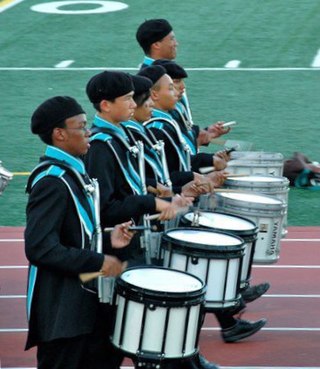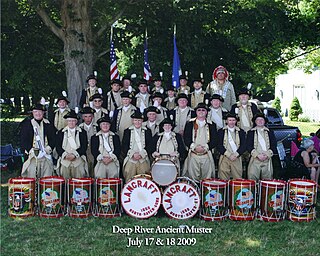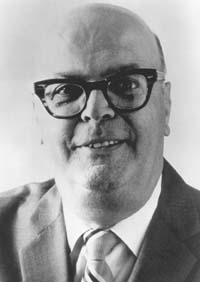Related Research Articles

The snare drum is a percussion instrument that produces a sharp staccato sound when the head is struck with a drum stick, due to the use of a series of stiff wires held under tension against the lower skin. Snare drums are often used in orchestras, concert bands, marching bands, parades, drumlines, drum corps, and more. It is one of the central pieces in a drum set, a collection of percussion instruments designed to be played by a seated drummer and used in many genres of music. Because basic rhythms are very easy to learn to play on a snare drum even for children, the instrument is also suitable for the music education for young children and a rhythm band.

Snare technique is the technique used to play a snare drum.

In rudimental drumming, a form of percussion music, a drum rudiment is one of a number of relatively small patterns which form the foundation for more extended and complex drumming patterns. The term "drum rudiment" is most closely associated with various forms of field drumming, where the snare drum plays a prominent role. In this context "rudiment" means not only "basic", but also fundamental. This tradition of drumming originates in military drumming and it is a central component of martial music.
Open, closed, open is a technique of playing snare drum rudiments, especially used during auditions or classical practice routines.
George Lawrence Stone (1886–1967) was an American drummer and author.
Sanford Augustus Moeller (1878–1960) was an American rudimental drummer, national champion, educator, and author. He was born in Albany, New York on February 16, 1878, and he began his music education by studying the piano.
George B. Bruce was an American Army drum major during the Civil War. Bruce is best known for co-writing The Drummer's and Fifer's Guide with Daniel Decatur Emmett.

Lancraft Fife and Drum Corps is an Ancient Fife and Drum Corps based in North Haven, Connecticut, and is a member of the Connecticut Fifers and Drummers Association. Lancraft was founded in 1888 by conservative Freemasons, but over the years has become the pride of Irish Americans.
Mitch Markovich is an American percussionist, composer, educator, and clinician in the areas of rudimental drumming, marching percussion, drum and bugle corps, and marching band. He is best known for his intensive marching snare drum solo compositions and record-setting performances, entitled "Tornado" and "Stamina", and for his percussion quartet composition entitled "Four Horsemen". Markovich's contributions to the style, notation, composition, and performance of percussion have endured over the last five decades.

Frank Arsenault was an internationally known American percussionist, teacher, and clinician in the areas of marching percussion, rudimental drumming, drum and bugle corps, and marching band. He was a full-time Staff Clinician and Educational Field Representative for the Ludwig Drum Company. He is also well known in his field for his signature playing style, for his many championship titles, and for his recording of The 26 Standard American Drum Rudiments and Selected Solos.
Ryan Alexander Bloom is an American drummer, author, and teacher. He is known for being a former member of the Colorado-based thrash metal band Havok, member of death metal band Bloodstrike, and the author of several books including Double Bass Drumming Explained, Thrash Metal DrummingEncyclopedia Rudimentia, and Rudimental Grand Tour
Charles "Charley" Wilcoxon was an American drum teacher and drum method book writer. He wrote several influential books on rudimental drumming that are still used by drum teachers today. He is a member of the Percussive Arts Society Hall of Fame.

William F. Ludwig was an American percussionist, drum-maker, and founder of Ludwig Drums. He helped to create the National Association of Rudimental Drummers and is a member of the Percussive Arts Society Hall of Fame.
Gardiner A. Strube was an American drum major in the New York National Guard and the author of a fife and drum manual.
The National Association of Rudimental Drummers is an organization created to encourage the study of rudimental drumming. NARD is responsible for the creation of the Standard 26 American Rudiments.
Alfons Grieder was a Swiss rudimental drummer who spread awareness of the Basel Drumming style in America during the mid to late 20th century through his traveling, teaching, and publications.
Jay Wanamaker is a percussionist and the president and CEO of Roland Americas and formerly held executive positions at Fender and Guitar Center. He also worked for Yamaha, Alfred Publishing, and the University of Southern California, and was chair of the Percussive Arts Society rudimental committee that published the 40 PAS Drum rudiments. He has also published over 50 music books and instructional DVDs.
John Sterling "Jack" Pratt (1931–2020) was an American Army drum instructor at West Point as well as a celebrated rudimental book author. Pratt produced several volumes of rudimental solos and instructional materials and was also the founder of the International Association of Traditional Drummers (IATD), a member of the National Association of Rudimental Drummers (NARD), a member of the United States Association of Rudimental Drummers (USARD), and was inducted into the Percussive Arts Society (PAS) Hall of Fame and the World Drum Corps Hall of Fame.
Edward B. Straight was an American drummer, founding member of the National Association of Rudimental Drummers, and author of several instructional drum books in the early days of drum kit playing.

John Patrick Noonan was an American percussionist, music educator and musical instrument retailer. He wrote for several publications including DownBeat, Metronome, The Instrumentalist, The School Musician and The Ludwig Drummer. Over his career, he performed under several prominent conductors including John Philip Sousa, Edwin Franko Goldman, and William Revelli.
References
- 1 2 3 "New Haven Museum » test".
- 1 2 3 4 "Field Drums (A/K/A Field of Drums): J. Burns Moore, a Short Autobiography". 21 September 2013.
- ↑ Barnhart, Stephen (2000). "J. Burns Moore". Percussionists Biographical Dictionary. Retrieved 2024-12-30.
- 1 2 3 Mazur, Ken. "The Perfectionists: The History of Rudimental Snare Drumming From Military Code to Field Competition." Percussive Notes. April 2005.
- ↑ Clark, James. Connecticut's Fife and Drum Tradition. Wesleyan University Press, 2011.
- 1 2 3 Beckham, Rick. "The Birth, Growth, and Metamorphosis of Competitive Rudimental Drumming" (PDF). Unknown.
- ↑ Beck, John H. Encyclopedia of Percussion. Routledge, 2013.
- ↑ "History of N.A.R.D."
- ↑ Moore, J. B. Art of Drumming. Chicago: WFL Drum Co, 1937.
- ↑ "Musical Instruments for Sale - New & Used Music Gear".
- ↑ Wm. F. Ludwig Rudimental Drum Album No. 1. Chicago: WFL Drum Co, 1940. Sound Recording.
- ↑ Fennell, Frederick. Ruffles and Flourishes: Music for Field Trumpets and Drums. Chicago: Mercury, 1957. Sound recording.
- ↑ "USARD Blog". www.usard.org. Archived from the original on 2016-10-25.
- ↑ Parker, Ty. "Awards & Recognitions | United States Association of Rudimental Drummers" . Retrieved 2024-12-30.